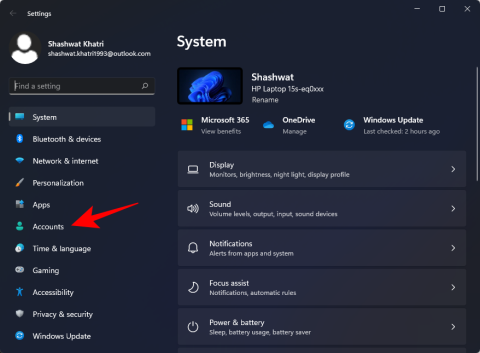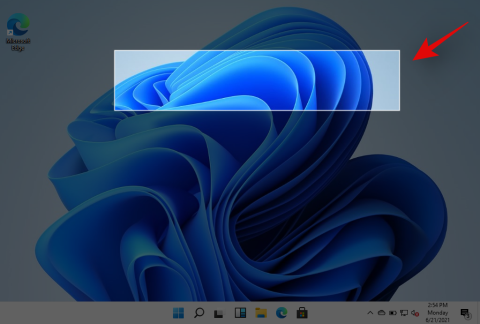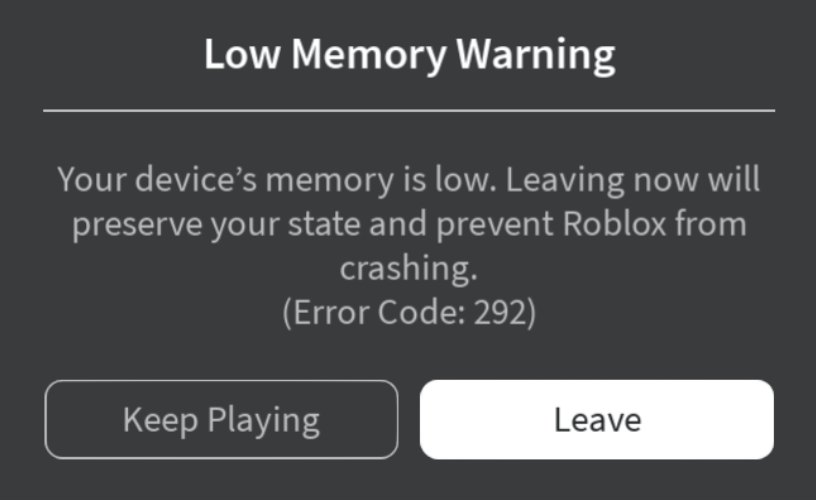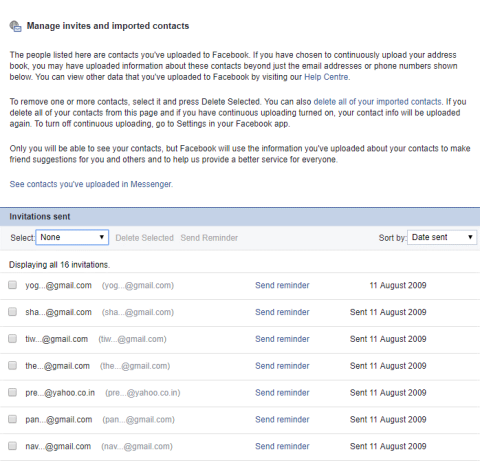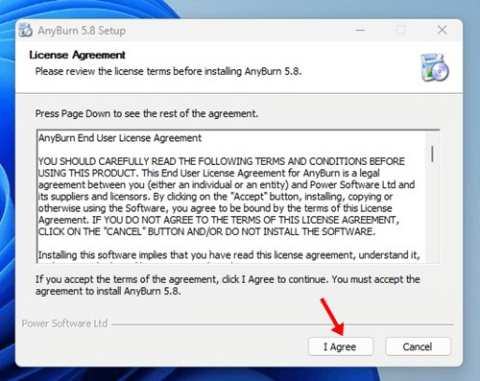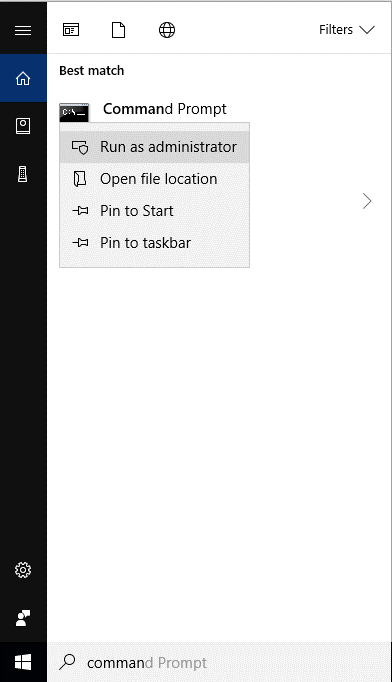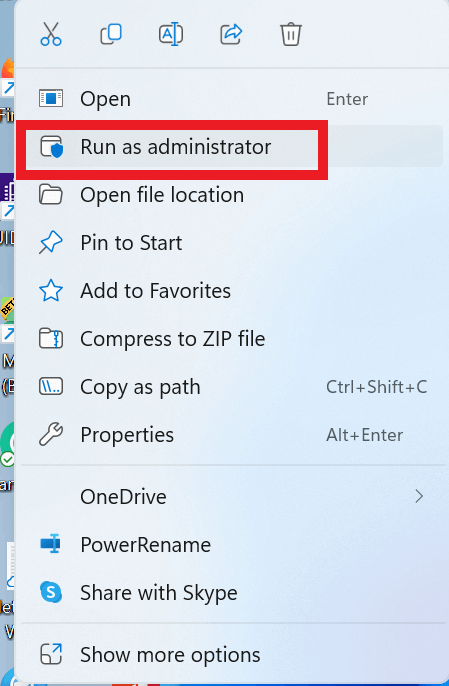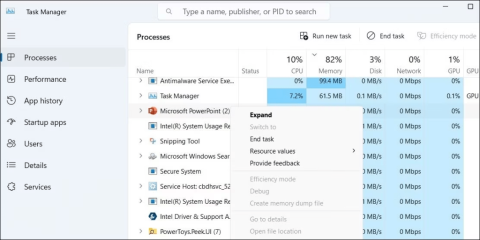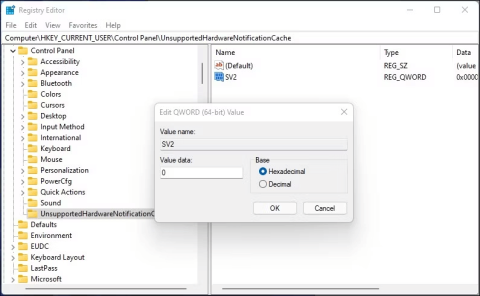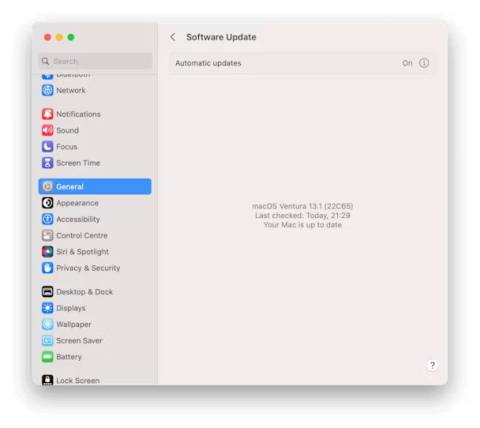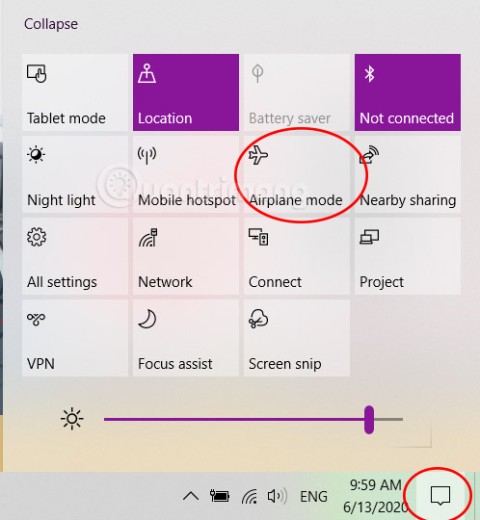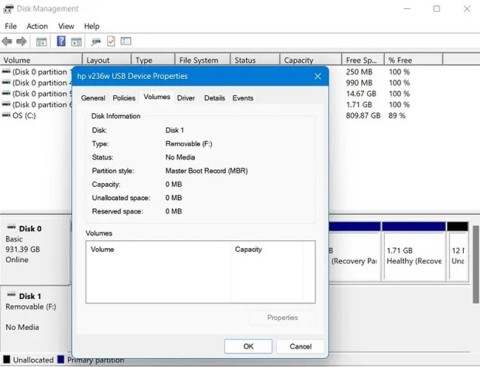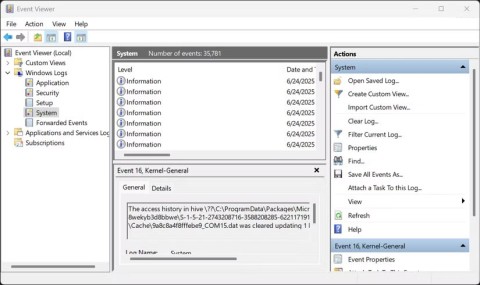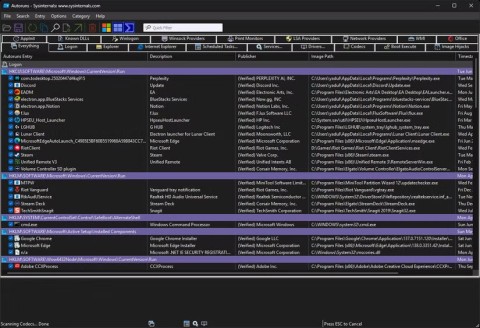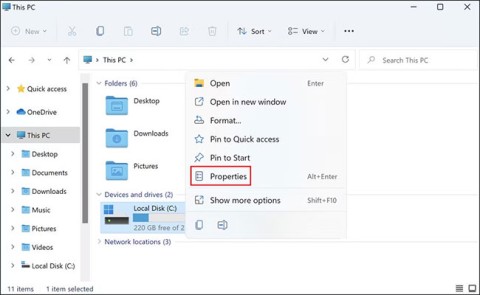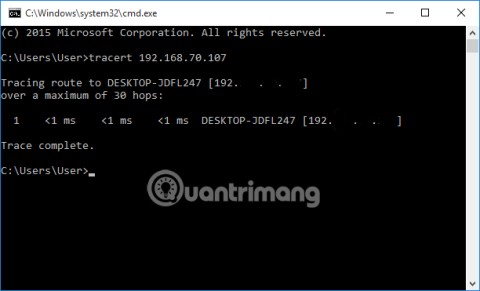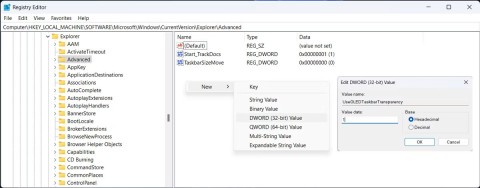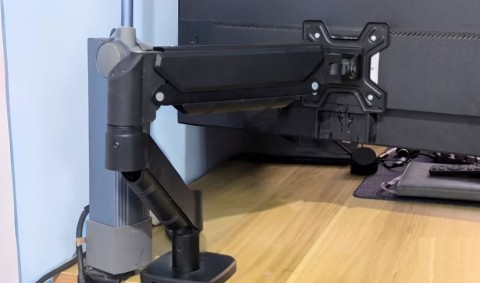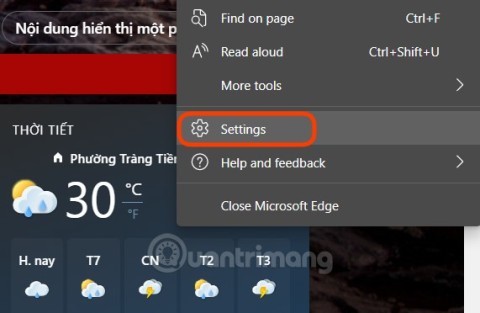6 τρόποι για να ενημερώσετε τα προγράμματα οδήγησης στα Windows 11
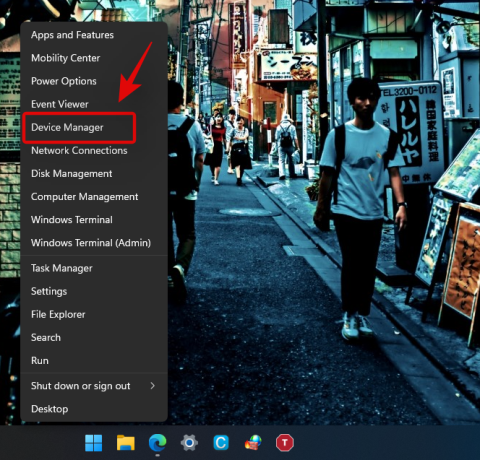
Ανακαλύψτε πώς να ενημερώσετε τα προγράμματα οδήγησης στα Windows 11 για να βελτιώσετε τη συμβατότητα και τις επιδόσεις.
Τα λειτουργικά συστήματα είναι η σωτηρία κάθε υπολογιστή καθώς, χωρίς αυτά, θα ήταν αδύνατο να στείλουμε email, να παρακολουθήσουμε βίντεο με γάτες ή να συνομιλήσουμε με τους φίλους μας. Αλλά κάθε τόσο, κάθε λειτουργικό σύστημα αντιμετωπίζει προβλήματα όπως αργές εκκινήσεις, σφάλματα εφαρμογών, δυσλειτουργική οθόνη, ασταθής ήχος και οτιδήποτε άλλο.
Εάν πιστεύετε ότι το αντίγραφό σας των Windows 11 συμπεριφέρεται επίσης περίεργα τον τελευταίο καιρό, πιστεύουμε ότι είναι καιρός να πάρετε την κατάσταση στα χέρια σας και να επιδιορθώσετε τα Windows 11.
Τώρα, προτού βιαστείτε για την πλησιέστερη τεχνολογία επισκευής υπολογιστή, ας ρίξουμε μια ματιά στις πολλές διαθέσιμες μεθόδους που έχετε στη διάθεσή σας που μπορούν να σας βοηθήσουν να επιδιορθώσετε μια κατεστραμμένη εγκατάσταση των Windows 11.
Περιεχόμενα
Μέθοδος #1: Χρησιμοποιήστε ένα πρόγραμμα αντιμετώπισης προβλημάτων των Windows
Τα προγράμματα αντιμετώπισης προβλημάτων των Windows έχουν προχωρήσει πολύ και μπορούν πλέον να διορθώσουν τα περισσότερα από τα προβλήματά σας με ένα απλό κλικ. Οι περισσότερες εντολές αντιμετώπισης προβλημάτων και οι έλεγχοι που πραγματοποιούνταν κανονικά μέσω CMD και PowerShell περιλαμβάνονται πλέον στο πρόγραμμα αντιμετώπισης προβλημάτων, γεγονός που τις καθιστά πολύ πιο εύχρηστες όταν αντιμετωπίζετε προβλήματα. Εάν εξακολουθείτε να μην μπορείτε να διορθώσετε και να επιδιορθώσετε την εγκατάσταση των Windows 11, τότε το εργαλείο αντιμετώπισης προβλημάτων μπορεί να αξίζει μια προσπάθεια. Χρησιμοποιήστε τον παρακάτω οδηγό για να ξεκινήσετε.
Πατήστε Windows + iστο πληκτρολόγιό σας για να ανοίξετε την εφαρμογή Ρυθμίσεις. Βεβαιωθείτε ότι το «Σύστημα» είναι επιλεγμένο στα αριστερά σας και, στη συνέχεια, κάντε κλικ στο «Αντιμετώπιση προβλημάτων» στα δεξιά σας.
![Πώς να επιδιορθώσετε τα Windows 11 [15 τρόποι] Πώς να επιδιορθώσετε τα Windows 11 [15 τρόποι]](https://img2.webtech360.com/resources8/images31/image-6439-0105182722076.png)
Κάντε κλικ στο «Άλλα εργαλεία αντιμετώπισης προβλημάτων».
![Πώς να επιδιορθώσετε τα Windows 11 [15 τρόποι] Πώς να επιδιορθώσετε τα Windows 11 [15 τρόποι]](https://img2.webtech360.com/resources8/images31/image-405-0105182722143.png)
Τώρα βρείτε το σχετικό εργαλείο αντιμετώπισης προβλημάτων για το τρέχον πρόβλημά σας, ανάλογα με το πρόβλημα που αντιμετωπίζετε με την εγκατάστασή σας. Κάντε κλικ στο «Εκτέλεση» δίπλα στο εργαλείο αντιμετώπισης προβλημάτων.
![Πώς να επιδιορθώσετε τα Windows 11 [15 τρόποι] Πώς να επιδιορθώσετε τα Windows 11 [15 τρόποι]](https://img2.webtech360.com/resources8/images31/image-9440-0105182722204.png)
Το εργαλείο αντιμετώπισης προβλημάτων θα κάνει τώρα το καθήκον του και θα διορθώσει τυχόν προβλήματα που εντοπίσει με το σχετικό στοιχείο ή δυνατότητα.
![Πώς να επιδιορθώσετε τα Windows 11 [15 τρόποι] Πώς να επιδιορθώσετε τα Windows 11 [15 τρόποι]](https://img2.webtech360.com/resources8/images31/image-9235-0105182955896.png)
Μέθοδος #2: Απεγκατάσταση και επανεγκατάσταση όλων των πρόσφατων ενημερώσεων των Windows
Εάν αντιμετωπίζετε τυχαία σφάλματα, αργή απόδοση, νευρικότητα ή σφάλματα μετά από μια πρόσφατη ενημέρωση των Windows, μπορείτε να δοκιμάσετε να απεγκαταστήσετε τις πρόσφατες ενημερώσεις για να λύσετε το πρόβλημά σας. Αυτές οι ενημερώσεις θα πρέπει να επαναφέρονται με επαναφορά συστήματος χρησιμοποιώντας τον οδηγό στο επάνω μέρος, αλλά σε περίπτωση που δεν έχετε σημείο επαναφοράς, μπορείτε να χρησιμοποιήσετε τον παρακάτω οδηγό για να απεγκαταστήσετε με μη αυτόματο τρόπο τις Ενημερώσεις των Windows από το σύστημά σας Windows 11.
Πατήστε Windows + iστο πληκτρολόγιό σας για να ανοίξετε την εφαρμογή Ρυθμίσεις. Τώρα κάντε κλικ στο Windows Update στα αριστερά σας.
![Πώς να επιδιορθώσετε τα Windows 11 [15 τρόποι] Πώς να επιδιορθώσετε τα Windows 11 [15 τρόποι]](https://img2.webtech360.com/resources8/images31/image-6752-0105182955965.png)
Κάντε κλικ στο «Ενημέρωση ιστορικού».
![Πώς να επιδιορθώσετε τα Windows 11 [15 τρόποι] Πώς να επιδιορθώσετε τα Windows 11 [15 τρόποι]](https://img2.webtech360.com/resources8/images31/image-9408-0105182722517.png)
Κάντε κύλιση προς τα κάτω και κάντε κλικ στο «Κατάργηση εγκατάστασης ενημερώσεων».
![Πώς να επιδιορθώσετε τα Windows 11 [15 τρόποι] Πώς να επιδιορθώσετε τα Windows 11 [15 τρόποι]](https://img2.webtech360.com/resources8/images31/image-1959-0105182722745.png)
Θα μεταφερθείτε τώρα στον πίνακα ελέγχου όπου θα λάβετε μια λίστα με όλες τις πρόσφατες σημαντικές ενημερώσεις που έχουν εγκατασταθεί στο σύστημά σας. Δεν θα λαμβάνετε ενημερώσεις ασφαλείας που αναφέρονται σε αυτήν τη λίστα, καθώς δεν είναι δυνατή η απεγκατάστασή τους για λόγους ασφαλείας. Κάντε κλικ και επιλέξτε την ενημέρωση που θέλετε να απεγκαταστήσετε.
![Πώς να επιδιορθώσετε τα Windows 11 [15 τρόποι] Πώς να επιδιορθώσετε τα Windows 11 [15 τρόποι]](https://img2.webtech360.com/resources8/images31/image-3028-0105182722836.png)
Τώρα κάντε κλικ στο «Κατάργηση εγκατάστασης» στο επάνω μέρος.
![Πώς να επιδιορθώσετε τα Windows 11 [15 τρόποι] Πώς να επιδιορθώσετε τα Windows 11 [15 τρόποι]](https://img2.webtech360.com/resources8/images31/image-2165-0105182722899.png)
Σημείωση: Εάν δεν έχετε την επιλογή Κατάργηση εγκατάστασης, τότε είναι πιθανό επειδή προσπαθείτε να απεγκαταστήσετε ένα ζωτικής σημασίας στοιχείο των Windows που θα μπορούσε να διακόψει τη λειτουργικότητα της τρέχουσας εγκατάστασης.
Κάντε κλικ στο «Ναι» για να επιβεβαιώσετε την επιλογή σας.
![Πώς να επιδιορθώσετε τα Windows 11 [15 τρόποι] Πώς να επιδιορθώσετε τα Windows 11 [15 τρόποι]](https://img2.webtech360.com/resources8/images31/image-9581-0105182722985.png)
Η επιλεγμένη ενημέρωση θα απεγκατασταθεί τώρα από το σύστημά σας. Σας συνιστούμε να επανεκκινήσετε το σύστημά σας και να ελέγξετε εάν το πρόβλημα που αντιμετωπίζατε έχει διορθωθεί. Εάν όχι, συνεχίστε την απεγκατάσταση των Windows Updates μέχρι να βρείτε τον ένοχο.
Μέθοδος #3: Επαναφορά σε παλαιότερο σημείο επαναφοράς συστήματος
Σημείωση: Αυτή η μέθοδος προϋποθέτει ότι έχετε ένα λειτουργικό αντίγραφο των Windows 11 στο οποίο μπορείτε να εκκινήσετε.
Μπορείτε να σκεφτείτε τα Σημεία Επαναφοράς Συστήματος ως διαδρομές για να επαναφέρετε το σύστημά σας σε προηγούμενη κατάσταση των Windows (όταν δημιουργήθηκε το Σημείο επαναφοράς) μαζί με τις εφαρμογές και τις ρυθμίσεις που είχε ο υπολογιστής σας τότε.
Τα Windows 11 δημιουργούν αυτόματα σημεία επαναφοράς συστήματος σε τακτά χρονικά διαστήματα. Εάν θέλετε, μπορείτε επίσης να δημιουργήσετε σημεία επαναφοράς.
Δημιουργούνται επίσης όταν εγκαθίσταται μια νέα εφαρμογή ή μια ενημέρωση των Windows.
Δείτε πώς μπορείτε να προσπαθήσετε να επιδιορθώσετε τα Windows 11 χρησιμοποιώντας σημεία επαναφοράς.
Ανοίξτε το μενού «Έναρξη» και πληκτρολογήστε «Δημιουργία σημείου επαναφοράς». Στη συνέχεια, κάντε κλικ στην επιλογή που φαίνεται παρακάτω.
![Πώς να επιδιορθώσετε τα Windows 11 [15 τρόποι] Πώς να επιδιορθώσετε τα Windows 11 [15 τρόποι]](https://img2.webtech360.com/resources8/images31/image-7098-0105182723056.png)
Θα πρέπει τώρα να ανοίξει ένα αναδυόμενο μενού με τον τίτλο «Ιδιότητες συστήματος» και θα πρέπει να μπορείτε να δείτε τις επιλογές που σχετίζονται με την Επαναφορά Συστήματος όπως φαίνεται παρακάτω.
![Πώς να επιδιορθώσετε τα Windows 11 [15 τρόποι] Πώς να επιδιορθώσετε τα Windows 11 [15 τρόποι]](https://img2.webtech360.com/resources8/images31/image-1063-0105182723121.png)
Εάν το αναδυόμενο μενού σας φαίνεται πανομοιότυπο με το δικό μας με την "Προστασία" απενεργοποιημένη για όλες τις μονάδες δίσκου σας, έχουμε άσχημα νέα για εσάς. Λόγω της έλλειψης προηγούμενων σημείων επαναφοράς συστήματος, δεν υπάρχει λόγος να συνεχίσετε περαιτέρω με αυτήν τη μέθοδο, καθώς δεν υπάρχει σημείο επαναφοράς στο οποίο μπορείτε να επιστρέψετε.
Σε αυτό το σημείο, συνιστούμε να δοκιμάσετε την επόμενη μέθοδο.
Συμβουλή: Εάν το διαβάζετε μόνο για να δείτε πώς λειτουργούν τα πράγματα, σας προτείνουμε να ενεργοποιήσετε την προστασία για τη μονάδα δίσκου του συστήματός σας (επισημαίνεται παρακάτω), αυτή που περιέχει τα Windows 11, και να δημιουργήσετε ένα σημείο επαναφοράς αυτήν τη στιγμή.
![Πώς να επιδιορθώσετε τα Windows 11 [15 τρόποι] Πώς να επιδιορθώσετε τα Windows 11 [15 τρόποι]](https://img2.webtech360.com/resources8/images31/image-2132-0105182723214.png)
Δείτε πώς μπορείτε να το κάνετε.
Επιλέξτε τη μονάδα δίσκου με την ένδειξη «System» και κάντε κλικ στο «Configure».
![Πώς να επιδιορθώσετε τα Windows 11 [15 τρόποι] Πώς να επιδιορθώσετε τα Windows 11 [15 τρόποι]](https://img2.webtech360.com/resources8/images31/image-6753-0105182723323.png)
Στη συνέχεια, κάντε κλικ στο κουμπί «Ενεργοποίηση προστασίας συστήματος» και εκχωρήστε λίγο χώρο για σημεία επαναφοράς συστήματος μετακινώντας το ρυθμιστικό παρακάτω. Έχουμε διαθέσει μόνο το 4% της μονάδας δίσκου του συστήματός μας, που είναι κοντά στα 4,5 GB.
Εάν τα σημεία επαναφοράς αυξηθούν σε αριθμό ή μέγεθος, τα παλαιότερα θα διαγραφούν αυτόματα για να δημιουργηθεί χώρος για νέα.
Κάντε κλικ στο «Εφαρμογή» και μετά στο «ΟΚ».
![Πώς να επιδιορθώσετε τα Windows 11 [15 τρόποι] Πώς να επιδιορθώσετε τα Windows 11 [15 τρόποι]](https://img2.webtech360.com/resources8/images31/image-2650-0105182723417.png)
Η μονάδα δίσκου που επιλέξατε νωρίτερα θα πρέπει τώρα να έχει ενεργοποιημένη την "Προστασία" και θα πρέπει πλέον να μπορείτε να δημιουργείτε σημεία επαναφοράς συστήματος.
![Πώς να επιδιορθώσετε τα Windows 11 [15 τρόποι] Πώς να επιδιορθώσετε τα Windows 11 [15 τρόποι]](https://img2.webtech360.com/resources8/images31/image-3719-0105182723520.png)
Ενώ βρίσκεστε στο ίδιο αναδυόμενο μενού, κάντε κλικ στο κουμπί "Δημιουργία" για να δημιουργήσετε το πρώτο σημείο επαναφοράς συστήματος του υπολογιστή σας.
![Πώς να επιδιορθώσετε τα Windows 11 [15 τρόποι] Πώς να επιδιορθώσετε τα Windows 11 [15 τρόποι]](https://img2.webtech360.com/resources8/images31/image-7789-0105182723725.png)
Θα πρέπει τώρα να εμφανιστεί ένα αναδυόμενο παράθυρο που θα ζητά το όνομα του σημείου επαναφοράς σας, μη διστάσετε να πληκτρολογήσετε οτιδήποτε θέλετε. Για τη δική σας διευκόλυνση, η τρέχουσα ώρα συστήματος και τα δεδομένα του υπολογιστή σας προστίθενται αυτόματα για να διακρίνεται αυτό το σημείο επαναφοράς από άλλα. Προς το παρόν, πληκτρολογούμε "Fresh Install" καθώς πρόσφατα εγκαταστήσαμε ξανά τα Windows 11.
Μόλις τελειώσετε, κάντε κλικ στο «Δημιουργία».
![Πώς να επιδιορθώσετε τα Windows 11 [15 τρόποι] Πώς να επιδιορθώσετε τα Windows 11 [15 τρόποι]](https://img2.webtech360.com/resources8/images31/image-2823-0105182723892.png)
Μετά από λίγο, το σημείο επαναφοράς θα πρέπει να είναι έτοιμο. Θα πρέπει τώρα να μπορείτε να το ελέγξετε κάνοντας κλικ στο κουμπί "Επαναφορά συστήματος".
![Πώς να επιδιορθώσετε τα Windows 11 [15 τρόποι] Πώς να επιδιορθώσετε τα Windows 11 [15 τρόποι]](https://img2.webtech360.com/resources8/images31/image-7821-0105182956057.png)
Κάντε κλικ στο Επόμενο.
![Πώς να επιδιορθώσετε τα Windows 11 [15 τρόποι] Πώς να επιδιορθώσετε τα Windows 11 [15 τρόποι]](https://img2.webtech360.com/resources8/images31/image-7756-0105182724049.png)
Και το σημείο επαναφοράς του συστήματος που δημιουργήθηκε πρόσφατα θα πρέπει να είναι εδώ.
![Πώς να επιδιορθώσετε τα Windows 11 [15 τρόποι] Πώς να επιδιορθώσετε τα Windows 11 [15 τρόποι]](https://img2.webtech360.com/resources8/images31/image-6893-0105182724113.png)
Επιλέγοντας το σημείο επαναφοράς και κάνοντας κλικ στο (μετά ενεργοποιημένο) κουμπί «Επόμενο» θα πρέπει να πραγματοποιήσετε επαναφορά του υπολογιστή σας στη στιγμή που δημιουργήθηκε το σημείο επαναφοράς.
Μέθοδος #4: Χρήση του εργαλείου γραμμής εντολών SFC
Το System File Checker (SFC) και το Deployment Image Servicing and Management (DISM) είναι δύο εργαλεία γραμμής εντολών που χρησιμοποιούνται πιο συχνά από τους τεχνικούς IT σε εταιρείες για την εξυπηρέτηση μηχανών Windows.
Αν είναι η πρώτη φορά που ακούτε για αυτά τα εργαλεία, τότε δεν υπάρχει τίποτα να ανησυχείτε, καθώς αυτά θεωρούνται γενικά ηλεκτρικά εργαλεία και δεν γνωρίζουν πολλοί άνθρωποι για αυτά.
Ας ξεκινήσουμε πρώτα με το SFC και ας δούμε πώς μπορείτε να επιδιορθώσετε τα Windows 11.
Το SFC μπορεί να χρησιμοποιηθεί για τη σάρωση και την επαλήθευση προστατευμένων αρχείων (αρχεία Windows). Εάν διαπιστώσει ότι ένα αρχείο έχει καταστραφεί και δεν μπορεί να επαληθευτεί, επιχειρεί να επαναφέρει ένα νέο αντίγραφο από τον παρακάτω φάκελο στον υπολογιστή σας.
C:\Windows
Δείτε πώς μπορείτε να δοκιμάσετε αυτήν την επιλογή.
Κάντε κλικ στο κουμπί «Έναρξη», πληκτρολογήστε «γραμμή εντολών» και φροντίστε να εκτελέσετε την εφαρμογή ως Διαχειριστής, όπως επισημαίνεται παρακάτω.
![Πώς να επιδιορθώσετε τα Windows 11 [15 τρόποι] Πώς να επιδιορθώσετε τα Windows 11 [15 τρόποι]](https://img2.webtech360.com/resources8/images31/image-8890-0105182956148.png)
Μόλις μπείτε στη γραμμή εντολών, πληκτρολογήστε την ακόλουθη εντολή ή απλώς αντιγράψτε και επικολλήστε την. Στη συνέχεια, πατήστε "Enter".
sfc /scannow
Η παραπάνω εντολή ξεκινά μια σάρωση αμέσως, η οποία διαρκεί περίπου λίγα λεπτά για έναν πλήρη έλεγχο.
![Πώς να επιδιορθώσετε τα Windows 11 [15 τρόποι] Πώς να επιδιορθώσετε τα Windows 11 [15 τρόποι]](https://img2.webtech360.com/resources8/images31/image-4377-0105182724504.png)
Εάν η σάρωση διαπιστώσει ότι όλα τα αρχεία σας είναι σε καλή κατάσταση, θα εμφανιστεί όπως παρακάτω.
![Πώς να επιδιορθώσετε τα Windows 11 [15 τρόποι] Πώς να επιδιορθώσετε τα Windows 11 [15 τρόποι]](https://img2.webtech360.com/resources8/images31/image-5446-0105182724592.png)
Αλλά αν υπάρχουν κάποια κατεστραμμένα αρχεία Windows στον υπολογιστή σας, το SFC θα πρέπει να μπορεί να τα διορθώσει με ένα νέο αντίγραφο.
Μέθοδος #5: Χρήση του εργαλείου γραμμής εντολών DISM
Το DISM είναι ένα άλλο εργαλείο γραμμής εντολών που είναι πολύ πιο ισχυρό από το SFC. Μπορεί να λειτουργήσει με πολλούς τύπους εικόνων των Windows 11 σε μορφές .wim και .esd, να διαχειριστεί προγράμματα οδήγησης πριν από την ανάπτυξη εικόνων σε υπολογιστές και πολλά άλλα.
Ας ρίξουμε μια ματιά στο πώς μπορείτε να χρησιμοποιήσετε το DISM για να επιδιορθώσετε τα Windows 11.
Ανοίξτε τη γραμμή εντολών ως διαχειριστής χρησιμοποιώντας τα βήματα που μόλις αναφέραμε για το SFC.
Στη συνέχεια, επικολλήστε την παρακάτω εντολή για να σαρώσετε την εγκατάσταση των Windows 11 για σφάλματα και πατήστε Enter.
Dism /Online /Cleanup-Image /ScanHealth
Θα πρέπει να δείτε κάτι τέτοιο.
![Πώς να επιδιορθώσετε τα Windows 11 [15 τρόποι] Πώς να επιδιορθώσετε τα Windows 11 [15 τρόποι]](https://img2.webtech360.com/resources8/images31/image-5068-0105182725172.png)
Μόλις ολοκληρωθεί, το εργαλείο θα πρέπει να αναφέρει τα ευρήματά του. Δείτε πώς φαίνεται η οθόνη μας.
![Πώς να επιδιορθώσετε τα Windows 11 [15 τρόποι] Πώς να επιδιορθώσετε τα Windows 11 [15 τρόποι]](https://img2.webtech360.com/resources8/images31/image-9689-0105182725280.png)
Στη συνέχεια, εκτελέστε αυτήν την εντολή για να δείτε εάν εντοπίστηκαν προβλήματα και πόσο επισκευάσιμο είναι το πρόβλημά σας.
Dism /Online /Cleanup-Image /CheckHealth
Καθώς ο υπολογιστής μας λειτουργούσε καλά, η παραπάνω εντολή ανέφερε μηδενικά προβλήματα. Το δικό σου μπορεί να είναι διαφορετικό.
![Πώς να επιδιορθώσετε τα Windows 11 [15 τρόποι] Πώς να επιδιορθώσετε τα Windows 11 [15 τρόποι]](https://img2.webtech360.com/resources8/images31/image-3654-0105182725335.png)
Εάν το DISM ανέφερε προβλήματα με τον υπολογιστή σας, η επόμενη εντολή που πρέπει να εκτελέσετε αναφέρεται παρακάτω. Επικολλήστε το και πατήστε "Enter".
DISM /Online /Cleanup-Image /RestoreHealth
Η παραπάνω εντολή θα ζητήσει έγκυρα αντίγραφα κατεστραμμένων αρχείων από το Windows Update. Δείτε πώς φαίνεται η εντολή σε δράση.
![Πώς να επιδιορθώσετε τα Windows 11 [15 τρόποι] Πώς να επιδιορθώσετε τα Windows 11 [15 τρόποι]](https://img2.webtech360.com/resources8/images31/image-7724-0105182725565.png)
Και να πώς φαίνεται μόλις ολοκληρωθεί η επεξεργασία.
![Πώς να επιδιορθώσετε τα Windows 11 [15 τρόποι] Πώς να επιδιορθώσετε τα Windows 11 [15 τρόποι]](https://img2.webtech360.com/resources8/images31/image-9311-0105182725854.png)
Το μόνο που χρειάζεται να κάνετε είναι να επανεκκινήσετε τον υπολογιστή σας.
Εάν θεωρείτε τον εαυτό σας κάποιον που κατανοεί τα εργαλεία γραμμής εντολών και τις παραμέτρους τους και θα θέλατε να μάθετε περισσότερα για το SFC και το DISM μαζί με το εύρος των παραμέτρων που μπορούν να χρησιμοποιηθούν με αυτά, εδώ είναι η πλήρης τεκμηρίωση για το SFC και εδώ είναι η πλήρης αναφορά για το DISM . Διασκεδάστε με τις πληροφορίες!
Συμβουλή: Εάν η επεξεργασία των Windows 11 σας διακόπτεται συχνά, κάντε επανεκκίνηση λίγα δευτερόλεπτα αργότερα και εμφανίσει μια ειδοποίηση με ένα σωρό αριθμούς και αλφάβητα (γνωστοί και ως κωδικοί σφάλματος), συνιστούμε ανεπιφύλακτα να τα τοποθετήσετε σε μια μηχανή αναζήτησης όπως το Google και να κατανοήσετε τι σημαίνουν. Αυτή η μέθοδος αντιμετώπισης προβλημάτων είναι εξαιρετικά αποτελεσματική έναντι συγκεκριμένων σφαλμάτων και προβλημάτων και συχνά μπορεί να αποδειχθεί σωτήρια.
Μέθοδος #6: Χρήση επιδιόρθωσης εκκίνησης των Windows 11
Τα Windows 11 είναι εξοπλισμένα με ένα ενσωματωμένο εργαλείο επισκευής εκκίνησης που έχει σχεδιαστεί για να εντοπίζει και να επιδιορθώνει κοινά προβλήματα εκκίνησης που μπορεί να αντιμετωπίζετε. Ας ρίξουμε μια ματιά στο πώς μπορείτε να χρησιμοποιήσετε το Startup Repair για να διορθώσετε τα Windows 11.
Ανοίξτε το μενού «Έναρξη» και κάντε κλικ στο κουμπί «Λειτουργία».
![Πώς να επιδιορθώσετε τα Windows 11 [15 τρόποι] Πώς να επιδιορθώσετε τα Windows 11 [15 τρόποι]](https://img2.webtech360.com/resources8/images31/image-3277-0105182725914.png)
Κρατήστε πατημένο το πλήκτρο «Shift» και κάντε κλικ στο «Επανεκκίνηση».
![Πώς να επιδιορθώσετε τα Windows 11 [15 τρόποι] Πώς να επιδιορθώσετε τα Windows 11 [15 τρόποι]](https://img2.webtech360.com/resources8/images31/image-794-0105182726004.png)
Ο υπολογιστής σας θα πρέπει να εκκινήσει σε μπλε οθόνη με πολλές επιλογές. Κάντε κλικ στο «Αντιμετώπιση προβλημάτων».
![Πώς να επιδιορθώσετε τα Windows 11 [15 τρόποι] Πώς να επιδιορθώσετε τα Windows 11 [15 τρόποι]](https://img2.webtech360.com/resources8/images31/image-5932-0105182726311.jpg)
Click on ‘Advanced Options’.
![Πώς να επιδιορθώσετε τα Windows 11 [15 τρόποι] Πώς να επιδιορθώσετε τα Windows 11 [15 τρόποι]](https://img2.webtech360.com/resources8/images31/image-5382-0105182726417.jpg)
Click on ‘Startup Repair’.
Soon after, Windows should now be scanning and diagnosing your PC for any issues that may be preventing it from functioning properly. Let it work its magic and after some time, your copy of Windows 11 should be free of all the problems.
Tip: If ‘Startup Repair’ fails and you see the screen shown below, there could be two possible reasons for this. Either Windows 11 failed to identify the issues or there is simply no issue with your PC.
![Πώς να επιδιορθώσετε τα Windows 11 [15 τρόποι] Πώς να επιδιορθώσετε τα Windows 11 [15 τρόποι]](https://img2.webtech360.com/resources8/images31/image-4518-0105182726486.jpg)
At this point, you could try to follow method #3’s option 2 to initiate a repair of Windows 11. You could also try to reinstall Windows 11 by using the “Upgrade” option in Windows 11 setup, instead of going for a clean install and wiping your drive.
This install method should reinstall Windows 11 while keeping all your files, apps, and settings.
Method #7: Using Windows 11 installer ISO file
Did you know that the files you used to install Windows 11, could also be used to repair a damaged copy of Windows 11?
Not a lot of people know this but it can easily be done and doesn’t take too long at all.
To make this method work, you need access to Windows 11 installation files (ISO) or the installer USB drive you may have used earlier to install Windows 11.
Option 1: Using the setup file from the Windows 11 ISO
See if you have the Windows 11 ISO stored somewhere on your PC. If you do, perfect! No need to download anything.
In case you don’t have the Windows 11 ISO around, we suggest you follow this guide to download the latest available ISO.
Before proceeding, make sure you can boot into Windows 11 and access the ISO. If you can, let’s move to the next step.
Locate the Windows 11 ISO and double-click it.
![Πώς να επιδιορθώσετε τα Windows 11 [15 τρόποι] Πώς να επιδιορθώσετε τα Windows 11 [15 τρόποι]](https://img2.webtech360.com/resources8/images31/image-7519-0105182726601.png)
The ISO should now be mounted on a virtual disk drive on your Windows 11 PC and should look similar to this
![Πώς να επιδιορθώσετε τα Windows 11 [15 τρόποι] Πώς να επιδιορθώσετε τα Windows 11 [15 τρόποι]](https://img2.webtech360.com/resources8/images31/image-6969-0105182726712.png)
Double-click the virtual drive. Once inside, there should be a file named ‘setup’, double-click it.
![Πώς να επιδιορθώσετε τα Windows 11 [15 τρόποι] Πώς να επιδιορθώσετε τα Windows 11 [15 τρόποι]](https://img2.webtech360.com/resources8/images31/image-4486-0105182726796.png)
Tip: Alternatively, you can also extract the ISO somewhere on your pc, which of course would take a bit of time but should give you the same result.
Wait for the Windows 11 setup to start. Once done, you should see a screen similar to below. Click on ‘Next’.
![Πώς να επιδιορθώσετε τα Windows 11 [15 τρόποι] Πώς να επιδιορθώσετε τα Windows 11 [15 τρόποι]](https://img2.webtech360.com/resources8/images31/image-3622-0105182726853.png)
Accept the Terms & Conditions.
![Πώς να επιδιορθώσετε τα Windows 11 [15 τρόποι] Πώς να επιδιορθώσετε τα Windows 11 [15 τρόποι]](https://img2.webtech360.com/resources8/images31/image-4691-0105182726957.png)
Choose the option that best suits you here and click ‘Next’. We would like to keep our files, hence we’ve chosen ‘Keep personal files and apps’.
![Πώς να επιδιορθώσετε τα Windows 11 [15 τρόποι] Πώς να επιδιορθώσετε τα Windows 11 [15 τρόποι]](https://img2.webtech360.com/resources8/images31/image-4141-0105182727056.png)
Click on ‘Install’ to start the installation.
![Πώς να επιδιορθώσετε τα Windows 11 [15 τρόποι] Πώς να επιδιορθώσετε τα Windows 11 [15 τρόποι]](https://img2.webtech360.com/resources8/images31/image-7142-0105182727192.png)
After a few seconds, setup should start preparing your PC for an in-place upgrade, which will repair and refresh all the files needed to run Windows 11 on your PC.
![Πώς να επιδιορθώσετε τα Windows 11 [15 τρόποι] Πώς να επιδιορθώσετε τα Windows 11 [15 τρόποι]](https://img2.webtech360.com/resources8/images31/image-4659-0105182727255.png)
Your PC may reboot a few times to complete the repair.
Once setup has finished, your copy of Windows 11 should be completely repaired and ready to use.
Option 2: Using a bootable USB drive
If for some reason, your PC fails to boot into Windows 11 or simply reboots repeatedly due to a corrupt Windows file, then this option will be perfect for you.
Before we start, see if you still have the Windows 11 USB install stick you may have used to install Windows 11 on your PC. If you do, then there’s nothing to worry about.
In case you don’t, here’s how you can create a Windows 11 USB installer within a couple of minutes. Do keep in mind that it requires another functional PC with internet to download Rufus and Windows 11 ISO. Simply connect the USB drive to your PC and restart your system. Press any key on your keyboard when prompted to boot from the recovery media and subsequently proceed to repair Windows with the on-screen instructions. You will have the option to reinstall Windows, fix missing files, fix boot order or even use CMD to perform your own checks. If you need any help, then you can this guide to reset Windows from within your recovery media setup and more.
Check this guide: How To Install Windows 11 From USB
Method #8: Repair or Fix Drivers
Many times you can face issues with your Windows installation due to incompatible, outdated, or conflicting drivers installed on your system. Drivers are essential programs that allow your components to communicate with your CPU and GPU for the proper functioning of your system. Having incompatible or conflicting drivers can cause issues with Windows and even take a significant impact on your performance. If some of your components seem to be misbehaving or you feel that your system is drastically slower than expected then it would be a good idea to check your drivers and perform any repairs if needed.
1. Check for conflicting or outdated drivers
Let’s check for conflicting or outdated drivers on your system. Windows automatically shows you a warning sign for misbehaving components or outdated drivers in Device Manager. Use the guide below to look for driver issues on your installation of Windows 11.
Press Windows + X on your keyboard and click on Device Manager.
![Πώς να επιδιορθώσετε τα Windows 11 [15 τρόποι] Πώς να επιδιορθώσετε τα Windows 11 [15 τρόποι]](https://img2.webtech360.com/resources8/images31/image-5728-0105182727364.png)
Look for components in the list with a warning side beside them. If any are found, use the methods below to troubleshoot driver issues on your system. However, if none are found then let’s check for new components on your system to identify misbehaving components.
Click on the ‘Scan for hardware changes’ button at the top of your screen.
![Πώς να επιδιορθώσετε τα Windows 11 [15 τρόποι] Πώς να επιδιορθώσετε τα Windows 11 [15 τρόποι]](https://img2.webtech360.com/resources8/images31/image-5177-0105182727469.png)
Windows will now scan for hardware changes and install any new components or drivers found on your PC.
![Πώς να επιδιορθώσετε τα Windows 11 [15 τρόποι] Πώς να επιδιορθώσετε τα Windows 11 [15 τρόποι]](https://img2.webtech360.com/resources8/images31/image-6246-0105182727564.png)
2. Fix driver issues
If you wish to fix driver issues on your system then you will need to reinstall drivers for the concerned component on your system. This can be done through Windows and manually as well. We recommend manually force removing drivers only if you are unable to remove the driver through Device Manager in Windows. Force removing the wrong drivers can cause serious issues on your system and even force you to reinstall Windows altogether. Hence, ensure that you identify and properly force remove drivers from your system only for the malfunctioning component. Use one of the guides below depending on your current needs and requirements.
Note: If you are using a laptop or a pre-built system then we recommend you download specific drivers for the concerned component from your OEM support side beforehand. This will allow you to install the necessary drivers easily once you have removed the malfunctioning driver.
Read: 6 Ways to Update Drivers on Windows 11
Option 1: Remove and reinstall a component through Device Manager
Press Windows + X on your keyboard and click on ‘Device Manager’.
![Πώς να επιδιορθώσετε τα Windows 11 [15 τρόποι] Πώς να επιδιορθώσετε τα Windows 11 [15 τρόποι]](https://img2.webtech360.com/resources8/images31/image-5728-0105182727364.png)
Right-click on the component for which you wish to remove the driver and select Properties.
![Πώς να επιδιορθώσετε τα Windows 11 [15 τρόποι] Πώς να επιδιορθώσετε τα Windows 11 [15 τρόποι]](https://img2.webtech360.com/resources8/images31/image-5695-0105182727667.png)
Now click and switch to the Driver tab at the top.
![Πώς να επιδιορθώσετε τα Windows 11 [15 τρόποι] Πώς να επιδιορθώσετε τα Windows 11 [15 τρόποι]](https://img2.webtech360.com/resources8/images31/image-3418-0105182727905.png)
Click on ‘Uninstall device’.
![Πώς να επιδιορθώσετε τα Windows 11 [15 τρόποι] Πώς να επιδιορθώσετε τα Windows 11 [15 τρόποι]](https://img2.webtech360.com/resources8/images31/image-2867-0105182728010.png)
Check the box for ‘Attempt to remove the driver for this device’.
![Πώς να επιδιορθώσετε τα Windows 11 [15 τρόποι] Πώς να επιδιορθώσετε τα Windows 11 [15 τρόποι]](https://img2.webtech360.com/resources8/images31/image-2316-0105182728120.png)
Finally, click on ‘Uninstall’.
![Πώς να επιδιορθώσετε τα Windows 11 [15 τρόποι] Πώς να επιδιορθώσετε τα Windows 11 [15 τρόποι]](https://img2.webtech360.com/resources8/images31/image-902-0105182728296.png)
The device driver will now be removed and the device will be uninstalled from your system. You will now be prompted to restart your device. Restart your device as soon as possible and then reinstall the concerned drivers from your OEM’s support site. If you do not have the concerned drivers on your OEM site, then simply scan for hardware changes using the guide above and the necessary drivers will be automatically installed on your system.
Option 2: Manually force remove a driver and reinstall it
You can also manually force remove a driver using a third-party utility. This is not recommended as if Windows is not allowing you to remove a driver then it is probably an essential component that could cause issues on your system. We recommend you properly identify the concerned drivers before removing them from your system. Additionally, you should keep the latest replacement drivers handy so that you can reinstall them as soon as possible. Use the guide below to manually force delete concerned drivers from your system.
We will be using Driver Store Explorer to manually force remove the concerned drivers from your system. Driver Store Explorer is an open-source utility used to identify and remove all the drivers installed on your system. It is hosted on GitHub and can be compiled natively too in case privacy is a concern.
Download Driver Store Explorer to your local storage using the link above. Extract the archive to a convenient location and then launch the app using Rapr.exe.
![Πώς να επιδιορθώσετε τα Windows 11 [15 τρόποι] Πώς να επιδιορθώσετε τα Windows 11 [15 τρόποι]](https://img2.webtech360.com/resources8/images31/image-3903-0105182728416.png)
The app will now launch and scan all the drivers installed on your system. Once the list shows up, you can sort it based on the various columns available to you. We recommend you sort your drivers by ‘Provider’ as this will make it easier for you to search the concerned driver based on the manufacturer. Click on Provider at the top to arrange all the drivers ascendingly based on their provider’s name.
![Πώς να επιδιορθώσετε τα Windows 11 [15 τρόποι] Πώς να επιδιορθώσετε τα Windows 11 [15 τρόποι]](https://img2.webtech360.com/resources8/images31/image-1420-0105182728498.png)
Scroll the list and identify the concerned driver. Once found check the box beside it.
![Πώς να επιδιορθώσετε τα Windows 11 [15 τρόποι] Πώς να επιδιορθώσετε τα Windows 11 [15 τρόποι]](https://img2.webtech360.com/resources8/images31/image-2489-0105182728594.png)
You can now also click on ‘Select oid drivers’ on your right to automatically identify and select other old drivers installed on your system. However, we wouldn’t recommend this on pre-built systems and laptops that can sometimes get faulty driver updates in the future as the device gets older which degrade overall performance in return.
![Πώς να επιδιορθώσετε τα Windows 11 [15 τρόποι] Πώς να επιδιορθώσετε τα Windows 11 [15 τρόποι]](https://img2.webtech360.com/resources8/images31/image-3558-0105182728684.png)
Check the box for ‘Force Deletion’ on your right.
![Πώς να επιδιορθώσετε τα Windows 11 [15 τρόποι] Πώς να επιδιορθώσετε τα Windows 11 [15 τρόποι]](https://img2.webtech360.com/resources8/images31/image-7422-0105182728754.png)
Finally, click on ‘Delete Driver(s)’. This will force delete all the selected drivers from your system. We highly recommend you restart your system after this and install the new updated drivers you downloaded as soon as possible.
![Πώς να επιδιορθώσετε τα Windows 11 [15 τρόποι] Πώς να επιδιορθώσετε τα Windows 11 [15 τρόποι]](https://img2.webtech360.com/resources8/images31/image-212-0105182728819.png)
If faulty drivers were the cause of your issues with Windows 11, then a manual reinstall should help fix this in most cases.
Method #9: Resetting your PC
Like Windows 10, Windows 11 also comes with a nifty feature called ‘Reset this PC’. This can be a lifesaver if you need to clean your PC and start over with Windows 11. Once initiated, the process will roll back Windows 11 to its factory settings.
Here’s how you can proceed with it.
Open the ‘Start’ menu and type in “reset this pc”. You should get a result similar to what’s shown below. Click on ‘Reset this PC’.
![Πώς να επιδιορθώσετε τα Windows 11 [15 τρόποι] Πώς να επιδιορθώσετε τα Windows 11 [15 τρόποι]](https://img2.webtech360.com/resources8/images31/image-3525-0105182728991.png)
You should now be in your PC’s Recovery section within the Settings app. To proceed with the reset, simply click on the ‘Reset PC’ button.
![Πώς να επιδιορθώσετε τα Windows 11 [15 τρόποι] Πώς να επιδιορθώσετε τα Windows 11 [15 τρόποι]](https://img2.webtech360.com/resources8/images31/image-4594-0105182729090.png)
The next screen should ask you if you’d like to keep your files or remove them entirely. Pick the appropriate option to start resetting your Windows 11.
![Πώς να επιδιορθώσετε τα Windows 11 [15 τρόποι] Πώς να επιδιορθώσετε τα Windows 11 [15 τρόποι]](https://img2.webtech360.com/resources8/images31/image-9527-0105182729253.png)
Your selection should be followed by a reboot or two and in a few minutes, your PC should boot into a refreshed Windows 11.
Method #10: Fix boot issues with Windows 11
If you are having boot issues with Windows 11 then we can use bootrec.exe tool to fix most boot issues. Use the guide below to run bootrec.exe on your system. You will need to boot into Windows Recovery and then use CMD to execute these commands though. Use one of the methods above to boot into recovery mode in Windows via Settings or a recovery media and then use the guide below to execute bootrec commands and fix boot issues with Windows 11.
When at the recovery screen press Shift + F10 to bring up the CMD at any point during the recovery process.
Type in the following command to run bootrec.exe and press Enter on your keyboard to execute it.
bootrec.exe
Enter the following command first and press Enter on your keyboard to execute it.
Bootrec /fixmbr
Now enter the one below and execute it.
Bootrec /fixboot
Finally, enter the command below to rebuild your boot device order.
Bootrec /rebuildbcd
And that’s it! We recommend you restart your system for good measure or exit the recovery screen and try booting into Windows again. If you were facing boot issues, then this will have most likely fixed the issue for you.
If you have been facing start menu issues within Windows 11 then there are many fixes that you can try. The new start menu seems to be a hit or miss with users and many have tried to customize it in their own way. This has been known to break start menu functionality with recent updates and if you are facing issues after a recent update then this is likely the cause for you as well.
You can use this comprehensive guide by us to fix all kinds of Start menu issues on your Windows 11 system. You will even find ways to restore the older start menu and new ways to get the start menu back up and running on your system in no time.
Related: How to Fix ‘Windows 11 Start Menu Not Working’ Issue? [17 Ways]
Method #12: Fix random app crashes
Random app crashes have been a known issue since Windows 11 was first announced and the first insider build hit the shelves. This is mainly due to some core changes to Windows that now break functionality for previously compatible programs with Windows 10. This might be heartbreaking for many users that are unable to get their favorite programs and apps back up and running within Windows 11. There are a couple of things you can do to fix this issue and the most prominent ones have been covered by us in this comprehensive guide. If you are facing random app crashes then this will most likely help you solve the majority of crashes on your system.
Read: How To Fix Software Crashing on Windows 11 Dev Build
Method #13: Fix corrupt registry
Registry changes, incorrect values, and deleted or missing registry entries can also cause a lot of issues with your system. Chances are that if you modified your registry with a registry hack or used a third-party tool to clean your registry then the values were messed up during this process.
Due to the core changes in Windows 11, the registry values, locations, and entries are different from the ones on Windows 10. Additionally, the ones that were okay to be deleted earlier might be vital to the functioning of Windows in the latest version.
Hence using a compatible cleaner or repair tool for the registry can remove vital values that could cause issues with your system. You can use the guide below to try and fix the registry on your Windows 11 installation. But as the OS is fairly new, this might not work for you and in case it doesn’t you will have to reset your Windows to restore your registry values to their default entries.
By this point, the registry should have been fixed on your system as you will have already run SFC and DISM scans on your system (as given above). However if your registry still seems to be corrupted, then you can use a third-party app to fix it.
We recommend you use CCleaner’s free utility which can be downloaded using the link above. Once downloaded, run the .exe file and install CCleaner on your system. Then launch the app and follow the on-screen instructions to fix your registry.
We recommend you do not clean your registry or temporary files using CCleaner until it has been officially updated to support Windows 11. As for fixing the registry, the app did not produce any issues on our end despite multiple tries so you should be safe to fix your registry using CCleaner.
Method #14: Fix lack of storage space
If you seem to be missing storage space to random files on your system and are unable to identify large files on your system then it is likely that temporary files have started to take a toll on your local storage. Windows 11 is designed to clear most temporary files by default but this can option can sometimes bug out which can cause a large number of temporary files to accumulate on your system.
You can use our guide to delete the temporary files from your system. Once deleted, you should be able to gain back some significant storage space especially after clearing previous Windows installation files and downloaded Windows Updates.
Method #15: Boot into safe mode to identify third party culprits
Lastly, it could also be that your issue is being caused by a third-party app. As Windows 11 is fairly new and most recent updates to popular apps are using compatibility layers to work, it is likely that you are facing a bug with a third-party app. Third-party apps can create huge conflicts and issues in the background depending on what they do and it can end up being quite tough to identify the culprit.
Thankfully, Windows comes with a safe mode to troubleshoot exactly this problem. Safe mode helps disable all third-party apps, services, and tasks in the background. You can then verify the functioning of Windows in safe mode and start removing the suspected culprits one by one.
Once you find the culprit, you can restore your previously removed apps and continue using the OS until a fix is released by the concerned developer.
Unfortunately, this is a tedious process and there is no way around it, but if a third-party app is causing issues on your system, safe mode can help you identify and remove the culprit easily. You can use this guide to help you navigate and activate safe mode in Windows 11.
You can also use this trick to directly restart your system in the advanced recovery options state. Click on the ‘Start’ menu icon in your taskbar.
Now click on the ‘Power’ icon.
![Πώς να επιδιορθώσετε τα Windows 11 [15 τρόποι] Πώς να επιδιορθώσετε τα Windows 11 [15 τρόποι]](https://img2.webtech360.com/resources8/images31/image-4249-0105182729349.png)
Hold down the ‘Shift’ key on your keyboard and then click on ‘Restart’.
![Πώς να επιδιορθώσετε τα Windows 11 [15 τρόποι] Πώς να επιδιορθώσετε τα Windows 11 [15 τρόποι]](https://img2.webtech360.com/resources8/images31/image-2835-0105182729531.png)
Your Windows 11 PC will now automatically reboot into the Advanced recovery options.
Click on ‘Troubleshoot’ to get started. Now, click Advanced options > See more recovery options > Startup Settings > Restart.
You will now get a list of all the ways your computer can start up with elevated settings or restricted services. You will have the following options for Safe modes.
Press the desired key on your keyboard and your system will automatically restart in the desired Safe mode.
Well, these are all the proven methods that you can try to repair corrupted Windows 11. Some of these methods are fairly easy to use, while some may seem advanced for an average joe.
If you ever feel stuck at any point while following our methods, drop us a comment and we’d be happy to sort out the confusion.
Related:
Ανακαλύψτε πώς να ενημερώσετε τα προγράμματα οδήγησης στα Windows 11 για να βελτιώσετε τη συμβατότητα και τις επιδόσεις.
Ανακαλύψτε πώς να αλλάξετε το χρώμα της γραμμής εργασιών στα Windows 11 με απλές μεθόδους για να προσαρμόσετε την εμφάνιση του υπολογιστή σας.
Όλα όσα πρέπει να γνωρίζετε για να δημιουργήσετε έναν νέο λογαριασμό χρήστη στα Windows 11, είτε τοπικό είτε διαδικτυακό.
Μάθετε πώς να εγκαταστήσετε τα Windows 11 χωρίς TPM χρησιμοποιώντας διαφορετικές μεθόδους για να παρακάμψετε τις απαιτήσεις ασφαλείας. Διαβάστε τον οδηγό μας για πληροφορίες και λύσεις.
Τα στιγμιότυπα οθόνης στα Windows 11 περιλαμβάνουν ποικιλία μεθόδων, συμπεριλαμβανομένων των Print Screen, Snip & Sketch και περισσότερο. Μάθετε πώς να τα χρησιμοποιήσετε!
Ανακαλύψτε πού βρίσκεται το My Computer στα Windows 11 και πώς να το επαναφέρετε εύκολα. Χρήσιμες μέθοδοι για Γενικές Χρήστες και Προχωρημένους.
Ανακαλύψτε πώς να σηκώσετε το χέρι στο Zoom με εύκολο και κατανοητό τρόπο. Ιδανικό για ομάδες τηλεδιάσκεψης. Δείτε λεπτομέρειες στα βήματα!
Το Zoom είναι μία από τις πιο δημοφιλείς εφαρμογές απομακρυσμένης συνεργασίας. Αποκαλύπτουμε χρήσιμες λύσεις για φαινόμενα ήχου και βίντεο.
Μην δημοσιεύετε τις φωτογραφίες σας δωρεάν στο Instagram όταν μπορείτε να πληρωθείτε για αυτές. Διαβάστε και μάθετε πώς να κερδίσετε χρήματα στο Instagram και να αξιοποιήσετε στο έπακρο αυτήν την πλατφόρμα κοινωνικής δικτύωσης.
Μάθετε πώς να επεξεργάζεστε και να αφαιρείτε μεταδεδομένα PDF με ευκολία. Αυτός ο οδηγός θα σας βοηθήσει να επεξεργαστείτε ή να αφαιρέσετε εύκολα τα μεταδεδομένα PDF με μερικούς εύκολους τρόπους.
Γνωρίζετε ότι το Facebook έχει μια πλήρη λίστα με τις επαφές του τηλεφωνικού σας καταλόγου μαζί με το όνομα, τον αριθμό και τη διεύθυνση email τους.
Το πρόβλημα μπορεί να εμποδίσει τη σωστή λειτουργία του υπολογιστή σας και μπορεί να χρειαστεί να αλλάξετε τις ρυθμίσεις ασφαλείας ή να ενημερώσετε τα προγράμματα οδήγησης για να τις διορθώσετε.
Αυτό το ιστολόγιο θα βοηθήσει τους αναγνώστες να μετατρέψουν το USB με δυνατότητα εκκίνησης σε αρχείο ISO χρησιμοποιώντας λογισμικό τρίτων κατασκευαστών που είναι δωρεάν στη χρήση και ασφαλές από κακόβουλο λογισμικό.
Αντιμετώπισε τον κωδικό σφάλματος 0x8007139F του Windows Defender και δυσκολεύεστε να εκτελέσετε σαρώσεις; Ακολουθούν τρόποι με τους οποίους μπορείτε να διορθώσετε το πρόβλημα.
Αυτός ο περιεκτικός οδηγός θα σας βοηθήσει να διορθώσετε το «Σφάλμα χρονοπρογραμματιστή εργασιών 0xe0434352» στον υπολογιστή σας με Windows 11/10. Δείτε τις διορθώσεις τώρα.
Το σφάλμα Windows LiveKernelEvent 117 προκαλεί απροσδόκητο πάγωμα ή απροσδόκητη διακοπή λειτουργίας του υπολογιστή σας. Μάθετε πώς να το διαγνώσετε και να το διορθώσετε με βήματα που προτείνουν οι ειδικοί.
Αυτό το ιστολόγιο θα βοηθήσει τους αναγνώστες να διορθώσουν το PowerPoint δεν θα μου επιτρέψει να εγγράψω προβλήματα ήχου σε υπολογιστή με Windows και ακόμη και να προτείνω άλλα υποκατάστατα εγγραφής οθόνης.
Αναρωτιέστε πώς να γράψετε σε ένα έγγραφο PDF αφού πρέπει να συμπληρώσετε φόρμες, να προσθέσετε σχολιασμούς και να βάλετε τις υπογραφές σας. Βρήκατε τη σωστή ανάρτηση, διαβάστε!
Αυτό το ιστολόγιο θα βοηθήσει τους χρήστες να αφαιρέσουν το υδατογράφημα Απαιτήσεις συστήματος που δεν πληρούνται για να απολαύσουν μια πιο ομαλή και ασφαλή εμπειρία με τα Windows 11, καθώς και μια πιο καθαρή επιφάνεια εργασίας.
Αυτό το ιστολόγιο θα βοηθήσει τους χρήστες MacBook να κατανοήσουν γιατί παρουσιάζονται τα προβλήματα με την ροζ οθόνη και πώς να τα διορθώσουν με γρήγορα και απλά βήματα.
Υπάρχουν πολλοί λόγοι για τους οποίους ο φορητός υπολογιστής σας δεν μπορεί να συνδεθεί στο WiFi και επομένως υπάρχουν πολλοί τρόποι για να διορθώσετε το σφάλμα. Εάν ο φορητός υπολογιστής σας δεν μπορεί να συνδεθεί στο WiFi, μπορείτε να δοκιμάσετε τους ακόλουθους τρόπους για να διορθώσετε αυτό το πρόβλημα.
Αφού δημιουργήσουν μια εκκίνηση USB για την εγκατάσταση των Windows, οι χρήστες θα πρέπει να ελέγξουν την απόδοση της εκκίνησης USB για να δουν αν δημιουργήθηκε με επιτυχία ή όχι.
Αρκετά δωρεάν εργαλεία μπορούν να προβλέψουν βλάβες μονάδων δίσκου προτού συμβούν, δίνοντάς σας χρόνο να δημιουργήσετε αντίγραφα ασφαλείας των δεδομένων σας και να αντικαταστήσετε τη μονάδα δίσκου εγκαίρως.
Με τα κατάλληλα εργαλεία, μπορείτε να σαρώσετε το σύστημά σας και να αφαιρέσετε λογισμικό υποκλοπής spyware, adware και άλλα κακόβουλα προγράμματα που ενδέχεται να κρύβονται στο σύστημά σας.
Όταν, για παράδειγμα, ένας υπολογιστής, μια κινητή συσκευή ή ένας εκτυπωτής προσπαθεί να συνδεθεί σε έναν υπολογιστή με Microsoft Windows μέσω δικτύου, ενδέχεται να εμφανιστεί το μήνυμα σφάλματος "δεν βρέθηκε η διαδρομή δικτύου" — Σφάλμα 0x80070035.
Η μπλε οθόνη θανάτου (BSOD) είναι ένα συνηθισμένο και όχι καινούργιο σφάλμα των Windows όταν ο υπολογιστής αντιμετωπίζει κάποιο σοβαρό σφάλμα συστήματος.
Αντί να εκτελούμε χειροκίνητες και άμεσες λειτουργίες πρόσβασης στα Windows, μπορούμε να τις αντικαταστήσουμε με διαθέσιμες εντολές CMD για ταχύτερη πρόσβαση.
Όπως και στα Windows 10, μπορείτε επίσης να χρησιμοποιήσετε λογισμικό τρίτων για να κάνετε τη γραμμή εργασιών των Windows 11 διαφανή.
Μετά από αμέτρητες ώρες χρήσης του φορητού και επιτραπέζιου ηχείου του πανεπιστημίου τους, πολλοί άνθρωποι ανακαλύπτουν ότι μερικές έξυπνες αναβαθμίσεις μπορούν να μετατρέψουν τον στενό χώρο της φοιτητικής τους εστίας στον απόλυτο κόμβο streaming χωρίς να ξοδέψουν μια περιουσία.
Από τα Windows 11, ο Internet Explorer θα καταργηθεί. Σε αυτό το άρθρο, το WebTech360 θα σας καθοδηγήσει πώς να χρησιμοποιήσετε τον Internet Explorer στα Windows 11.

